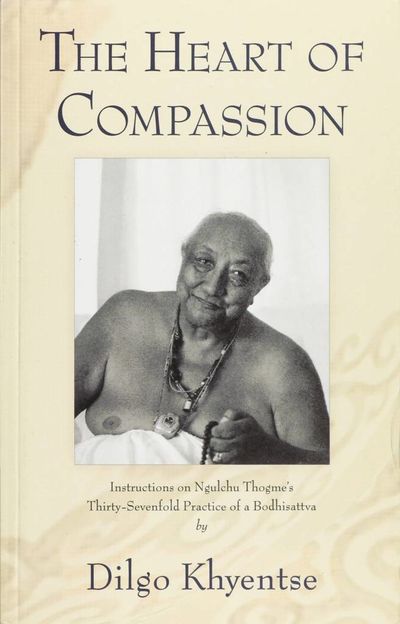- Translator's introduction9
- Gyalse Ngulchu Thogme (1295-1369)11
- THE ROOT TEXT27
- THE COMMENTARY37
- INTRODUCTION39
- OPENING VERSES44
- Homage44
- PART ONE – THE PREPARATION51
- First, the need to give meaning to this human existence of yours, so rare and difficult to obtain51
- Second, an exhortation to abandon your native land, the source of the three poisons58
- Third, a recommendation to live in solitary places, the source of all
good qualities60 - Fourth, to reflect on impermanence, in order to give up the concerns of this life63
- Fifth, the need to avoid unsuitable friends, being with whom creates adverse circumstances68
- Sixth, to rely on a spiritual teacher, whose presence creates conditions favorable to your progress69
- Seventh, to go for refuge, the entrance to the Buddhist teachings72
- PART ONE – THE PREPARATION51
- PART TWO – THE MAIN TEACHINGS, ILLUMINATING THE PATH81
- First, the path for beings of lesser capacity81
- Second, the path for beings of medium capacity85
- Third, the path for beings of superior capacity90
- 1. The bodhicitta of intention90
- 2. The bodhicitta of application97
- I. Relative bodhicitta97
- A. The meditation practice of exchanging oneself and
others98 - B. The post-meditation practice of using unfavorable circumstances on the path106
- i. Using on the path the four things that you do not
want to happen106- a. How to use loss on the path107
- b. How to use suffering on the path109
- c. How to use disgrace on the path111
- d. How to use disparagement on the path112
- ii. Using on the path the two things that are difficult to bear115
- a. How to use on the path being wronged in return for kindness115
- b. How to use humiliation on the path116
- iii. Using deprivation and prosperity on the path117
- a. How to use deprivation on the path117
- b. How to use prosperity on the path119
- iv. Using hatred and desire on the path120
- a. How to use objects of hatred on the path120
- b. How to use objects of desire on the path123
- i. Using on the path the four things that you do not
- A. The meditation practice of exchanging oneself and
- II. Absolute bodhicitta125
- I. Relative bodhicitta97
- PART TWO – THE MAIN TEACHINGS, ILLUMINATING THE PATH81
A. The meditation practice of remaining in a state free of conceptual elaborations without any clinging 125 B. The post-meditation practice of abandoning any belief in the objects of desire and aversion as truly existing 132 i. Abandoning any belief in the objects of desire as truly existing 132 ii. Abandoning any belief in the objects of aversion as truly existing 133 3. The precepts for training in those practices 136 I. Training in the Six Transcendent Perfections 136 A. Transcendent generosity 136 B. Transcendent discipline 139 C. Transcendent patience 141 D. Transcendent diligence 144 E. Transcendent concentration 148 F. Transcendent wisdom 152 II. Training in the Four Instructions taught in the Sutra 157 A. To examine oneselffor one's own defects and to give them up 157 B. To give up speaking of a bodhisattva's faults 160 C. To give up attachment to a sponsor's property 163 D. To give up harsh speech 165 Ill. Training in how to be rid of the negative emotions 166 IV. Training in accomplishing others' good with mindfulness and vigilance 170 V. Dedicating the merit to perfect enlightenment 173 CONCLUDING VERSES 177 1. How and for whom this text was composed 177 2. The unerring nature of these practices 179 3. A humble prayer for forgiveness 180 4. Dedicating the merit of having composed this text 181 5. The colophon 182 Final Advice 182 For Tsadra Internal Use Only About Kyabje Dilgo Khyentse Rinpoche (1910-1991) 185 APPENDIX 191 CoNTENTS 7 Appendix I • Supplementary Commentaries on the Spiritual Teacher (Verse 6) 193 A. The right and wrong teacher 193 B. A Practice of Guru Yoga 195 Appendix II • Supplementary Commentary on Desire (Verse 21) 199 The Dangers of Meat, Alcohol and Sex 199 Appendix Ill • Supplementary Commentaries on Transcendent Concentration (Verse 29) 202 A. Sustained Calm and Profound Insight 202 B. Concentration 206 Appendix IV • Supplementary Commentaries on Transcendent Wisdom 208 Appendix V • Mind-Training Prayer 211 Notes 218 Bibliography 230


